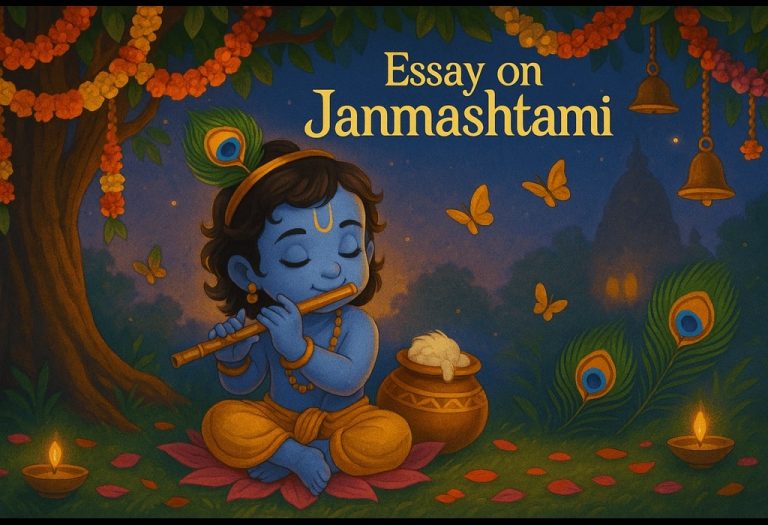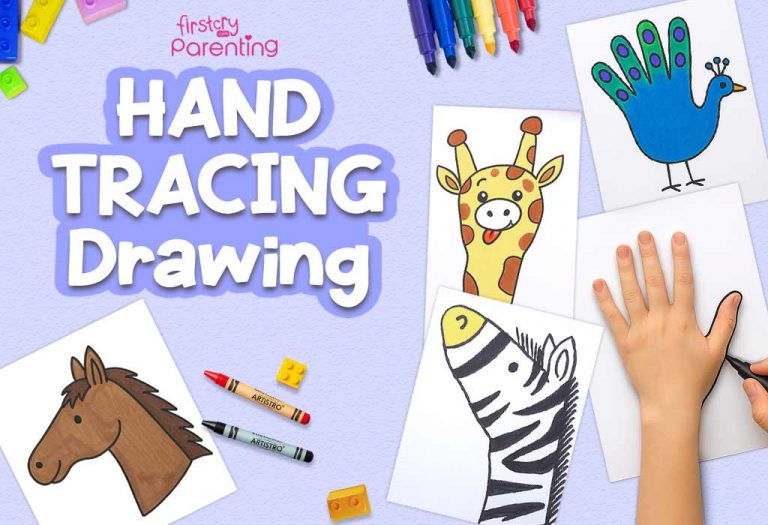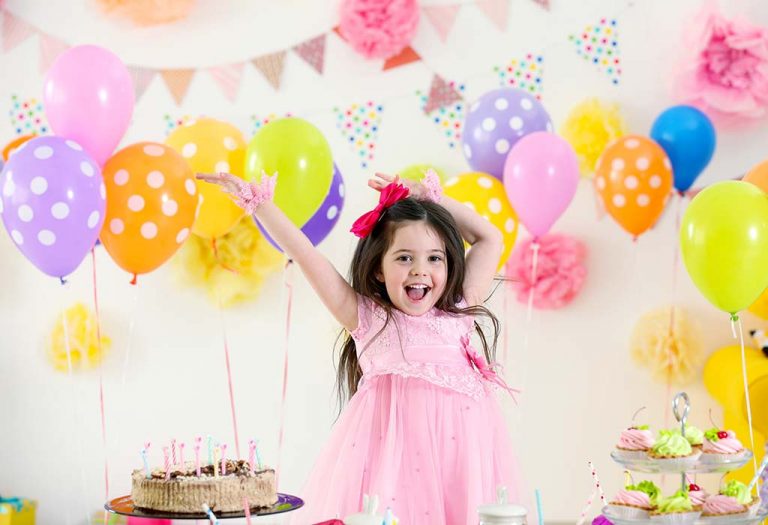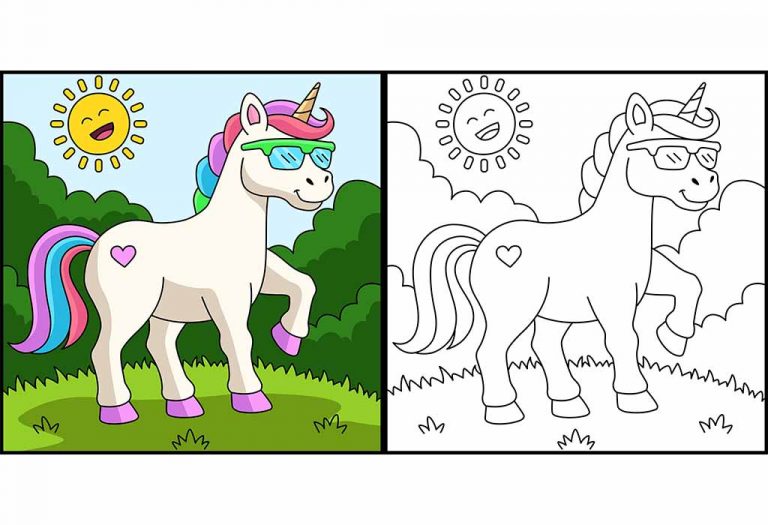Essay on Janmashtami in English for Students & Children
Janmashtami is a joyful and widely celebrated Hindu festival that marks the birth of Lord Krishna, the eighth avatar of Lord Vishnu. It is observed with great devotion across India and many parts of the world. Children and students are especially excited about the day because it involves colourful decorations, sweet treats, and engaging cultural performances.
The festival usually falls in August or September, depending on the lunar calendar. On this day, temples are beautifully decorated, devotees observe fasts, and people sing devotional songs called bhajans all night.
This essay on Krishna Janmashtami will help young learners understand the importance and traditions associated with the festival in a simple way. Whether you’re preparing for a school assignment or just wish to know more, this Janmashtami essay in English will give you all the essential details.
Five Lines on Krishna Janmashtami
For younger students, especially in early grades, short and simple essays are the easiest way to learn about festivals. These five-line essays help children remember key facts and understand the meaning of celebrations in a fun and easy format. Below is a 5-line essay for Class 1 that explains Janmashtami in a simple way.
- Krishna Janmashtami is celebrated as the birthday of Lord Krishna.
- People decorate temples and homes with flowers and lights.
- Devotees fast and sing bhajans throughout the day.
- Kids dress up as little Krishna and Radha in schools.
- It is a joyful festival filled with devotion and celebration.
10 Lines on Janmashtami
Short essays are a great way for children to learn about festivals in a simple way. This section includes ten lines on Janmashtami that are easy to understand and perfect as an essay for classes 1 and 2. These lines cover the main highlights of the festival.
- Janmashtami is the birthday of Lord Krishna, celebrated all over India.
- It usually falls in August or September based on the Hindu calendar.
- Stories of Krishna’s childhood are told to teach values like honesty and courage.
- Lord Krishna was born at midnight in Mathura to Devaki and Vasudeva.
- Many stay awake till midnight to celebrate the time of Krishna’s birth.
- Temples hold special prayers and offer sweets to the deity.
- Children enjoy dressing up as Krishna and Radha in schools.
- In Maharashtra, people celebrate Dahi Handi by forming human pyramids.
- The story of Krishna teaches us about kindness, love, and bravery.
- It is a special festival that brings happiness to children and families.
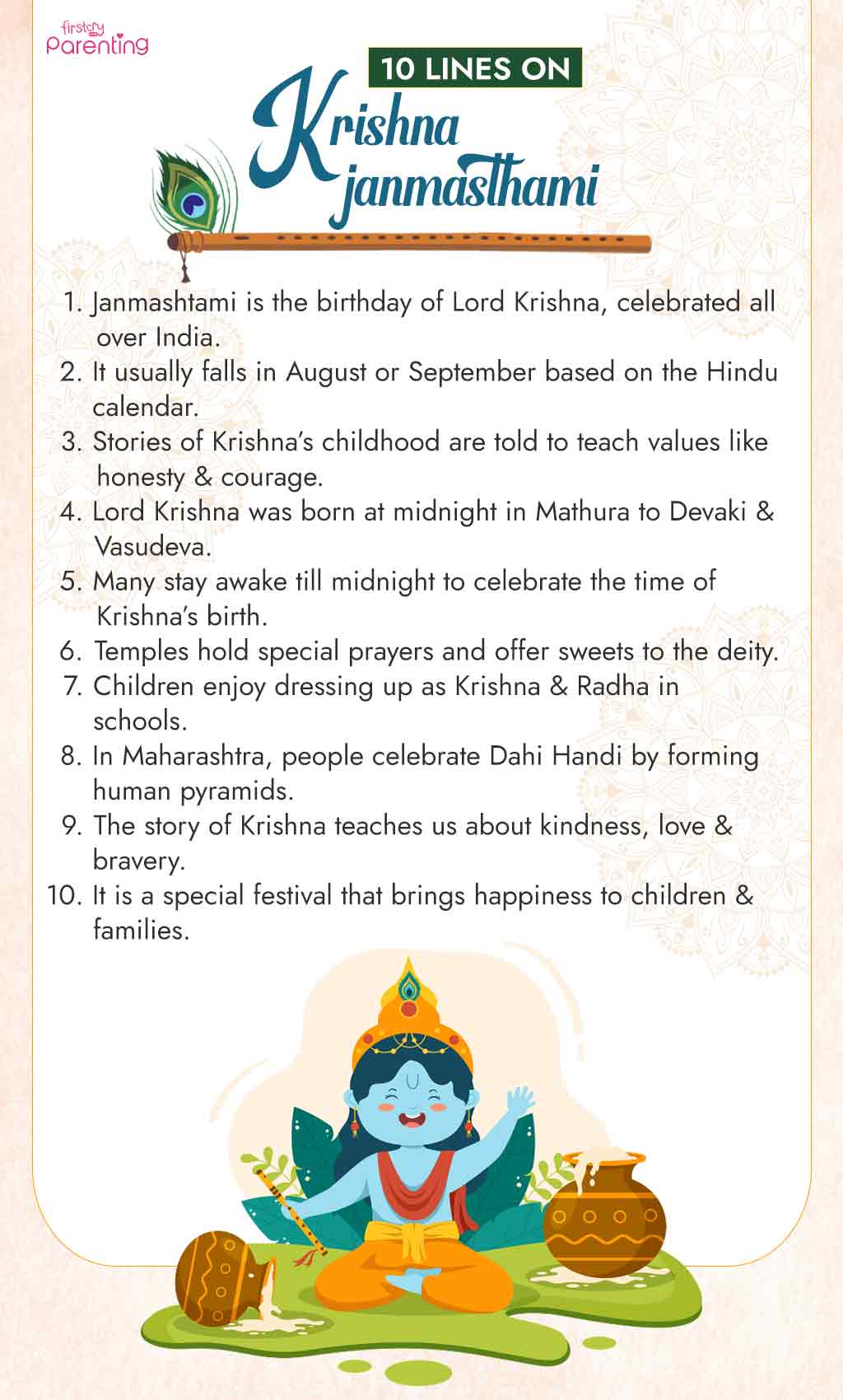
Paragraph on Janmashtami
For young learners, reading short paragraphs helps in understanding festivals better. This section includes a simple essay on Janmashtami in 100 words for Class 3. It explains the meaning and joy of the celebration in one small paragraph.
Janmashtami is a festival that celebrates the birth of Lord Krishna. People clean and decorate their homes and temples with lights and flowers. Devotees fast during the day and sing songs to welcome Krishna at midnight. Children dress up as Krishna and Radha and take part in fun programs at school. In many places, young people make human pyramids to break the Dahi Handi, just like Krishna did with his friends. Families pray together and enjoy sweets. The festival is full of happiness and devotion. It teaches us to be kind, honest, and loving, and brings peace and joy to all.
Short Essay on Krishna Janmashtami
This section covers a short essay on Krishna Janmashtami in around 200 words. It includes important points about the festival in a way that is easy for students to understand and remember.
Krishna Janmashtami is a Hindu festival celebrated to mark the birth of Lord Krishna. He was born in Mathura at midnight to Queen Devaki and King Vasudeva. Lord Krishna is known for his wisdom, kindness, and playful nature. His teachings are found in the holy book Bhagavad Gita.
On Janmashtami, people decorate their homes and temples with flowers, lights, and colourful designs. Devotees observe fasts and sing devotional songs throughout the day. At midnight, the idol of baby Krishna is placed in a cradle, and prayers are offered with joy and love. Special dishes and sweets made of milk and butter are prepared and shared with family and friends.
Children enjoy this festival by dressing up as Krishna and Radha. Schools also hold cultural programs and fancy dress competitions. In some parts of India, like Maharashtra, the Dahi Handi event is held where young boys form human pyramids to break a pot filled with curd.
Janmashtami teaches us to follow the path of truth and goodness. It brings people together and fills hearts with devotion. The festival is not only about fun but also about learning the values taught by Lord Krishna.
Long Essay on Janmashtami
When students learn through long essays, they get a better understanding of our festivals and traditions. Below is a long essay on Janmashtami, divided into helpful sections so children can follow along without confusion.
Celebrated on the eighth day (Ashtami) of the Krishna Paksha (dark fortnight) in the month of Bhadrapada (August–September), Janmashtami is more than just a religious event. It marks the birth of Lord Krishna, the eighth avatar of Vishnu.
Historical Significance of Krishna Janmashtami
Janmashtami holds a deep spiritual meaning for people who follow his teachings. Lord Krishna is believed to be the eighth avatar of Lord Vishnu. He was born to protect the good, punish the wicked and guide people towards truth and peace.
The festival reminds us of the values Lord Krishna stood for. His messages from the Bhagavad Gita are followed even today. He taught people to do their duty without expecting rewards. Janmashtami is not just a festival of devotion but also of learning. It connects people to their roots and helps children learn about India’s rich culture and beliefs. Many temples and places related to Krishna’s life become centres of grand celebration during this time.
Story of Krishna’s Birth
The story of Krishna’s birth is full of magic and lessons. He was born in Mathura to Queen Devaki and King Vasudeva. His uncle Kansa was a cruel king who had been warned by a voice from the sky that Devaki’s eighth son would end his rule. Out of fear, Kansa put Devaki and Vasudeva in prison and killed their first six children.
The seventh child, Balarama, was safely moved to another womb. When the eighth child, Krishna, was born, the prison guards fell asleep, and the locks opened by themselves. Vasudeva carried baby Krishna in a basket across the Yamuna River during a heavy storm. He took him to Gokul and handed him to Yashoda and Nanda to keep him safe.
Krishna grew up in Gokul, where he showed many divine powers even as a child. He loved playing with his friends, stealing butter, and protecting people from danger. His childhood stories are full of fun and lessons that children enjoy learning.
How to Celebrate Janmashtami
Janmashtami is celebrated with great happiness and faith in many parts of India. People clean and decorate their homes and temples with flowers and lights. They prepare sweets and special dishes to offer to Lord Krishna. Devotees observe fasts throughout the day and spend time singing bhajans and reading stories about Krishna.
At midnight, when Krishna is believed to be born, his idol is bathed and dressed in new clothes. The idol is placed in a small cradle and rocked gently by the devotees. This moment is full of joy and emotion for all who take part.
Children look forward to the festival because they get to dress up as Krishna and Radha. Schools and community groups organise events like singing, dancing, and fancy dress competitions. In some states like Maharashtra, Dahi Handi is a big event. A pot filled with curd is tied high up, and young boys form human pyramids to break it, just like Krishna did with his friends.
Many people also visit temples or join online celebrations if they cannot go out. Homes are filled with the sounds of devotional songs and stories about Krishna. Everyone joins together in prayer and celebration, making it a festival that brings families and communities closer.
Key Points to Remember When Writing a Janmashtami Essay
Writing an essay becomes easier when you know what to include and how to keep it simple. These key points will help students write clearly and stay focused on the topic. The list below can guide you while writing any Janmashtami essay in school or for homework.
- Mention that Janmashtami is the birthday of Lord Krishna.
- Include where and when Krishna was born.
- Write about why the festival is celebrated with devotion.
- Talk about how people celebrate Janmashtami at home and in temples.
- Mention school celebrations like fancy dress and cultural programs.
- Add a few lines about Krishna’s childhood and his teachings.
- Use simple words and short sentences to keep it easy to read.
- Avoid repeating the same ideas again and again.
- Keep the tone positive and joyful to match the spirit of the festival.
- End the essay with a short message or learning from Lord Krishna’s life.
What Will a Child Learn From the Janmashtami Essay?
An essay about Janmashtami helps children know why we celebrate the birth of Lord Krishna. It teaches values like honesty, love, and kindness through simple stories. Kids also learn how families and temples celebrate this festival with devotion and joy. They understand the importance of good actions and helping others.
FAQs
1. What lessons can we learn from Lord Krishna’s childhood stories?
Krishna’s stories teach us kindness, bravery, friendship, and standing up for truth, even when facing difficulties.
2. What is the meaning of Krishna’s flute?
Krishna’s flute is a symbol of peace, love, and attraction. It is believed to bring joy to those who hear it.
Janmashtami teaches children about the birth and values of Lord Krishna in a simple way. From stories to songs, every part of the celebration holds love and learning. Children enjoy dressing up and taking part in fun school events. Families prepare sweets, decorate homes, and pray with full faith. The festival also reminds us to be kind, honest, and brave just like Krishna. Celebrating Janmashtami helps children connect with culture and grow with good values.
Also Read:
Childhood Krishna Stories for Kids
Tips to Ensure Child Safety in Dahi Handi
Janmashtami Celebration Ideas for Children
10+ Best Krishna Janmashtami Activities and Celebration Ideas For Kids
Was This Article Helpful?
Parenting is a huge responsibility, for you as a caregiver, but also for us as a parenting content platform. We understand that and take our responsibility of creating credible content seriously. FirstCry Parenting articles are written and published only after extensive research using factually sound references to deliver quality content that is accurate, validated by experts, and completely reliable. To understand how we go about creating content that is credible, read our editorial policy here.





